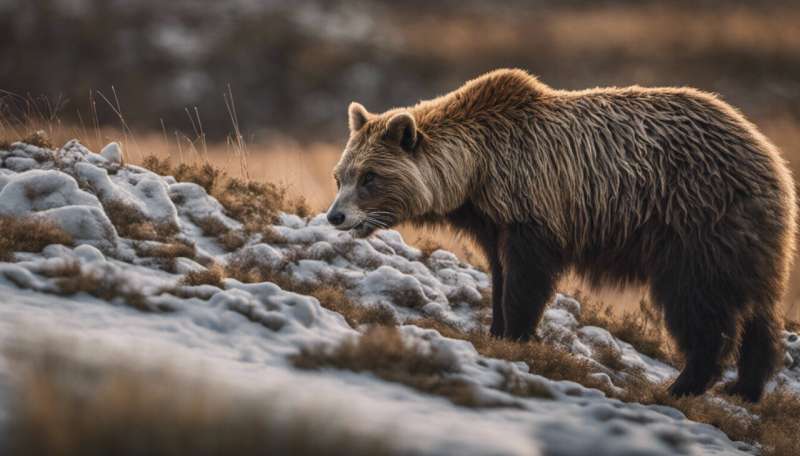
At one point in 2020, 4.4 billion people—more than half of the world’s population—were under lockdown restrictions to stem the spread of COVID-19. This was such a sudden and substantial event that it has become known as the anthropause.
Many bustling cities fell silent, often with restaurants, shops and schools closing, and only essential services allowed to operate. It was around this time when people started to report animals appearing in unusual places. For example, cougars were seen prowling through the suburbs of Santiago, Chile, golden jackals became more active during the day in Tel Aviv, Israel, and dolphins appeared in the normally busy harbor of Trieste, Italy.
Meanwhile, scientists began to wonder whether this tragic event could provide an opportunity to learn how humans impact the behavior of wildlife. A group of animal movement researchers came together in 2020 and formed the COVID-19 Bio-Logging Initiative, which I joined in 2021.
The initiative includes researchers who were already studying animals before the pandemic, and who were using bio-logging devices, such as GPS tags, to record animal movements. These devices—which use technology that you might find in a smartphone or watch—were still recording information while research teams were under lockdown.
What animals did in lockdown
We were interested in finding out how animal movements might have changed when human activities were restricted—were the animals really altering their behavior because human mobility had changed, or was it that people had more time to notice animals in these apparently unusual places? The initiative includes several projects tackling this question from different angles, with our first findings now published.
My colleague Marlee Tucker, an ecologist from Radboud University in the Netherlands, led an international team of 174 scientists who focused on studying whether the behavior of large land mammals changed during the pandemic. Our results are in the journal Science.
By pooling data from over 2,300 individual tracked mammals, from 43 species including elephants, giraffes, bears, deer and cougars, we were able to look at how their behavior and movement patterns changed during the lockdowns in 2020 compared to the same period one year earlier.
Animal movements can be influenced both by human mobility—people and vehicles moving in the landscape—and the built environment. It is normally impossible to distinguish these two effects because they are closely matched with each other, but the lockdown provided a chance for us to do this.
Exploring new areas
We found that mammals were 36% closer to roads during lockdown, and that their movement distances over ten days were 73% longer during strict lockdowns compared to the same period one year earlier. It may be that mammals ventured closer to roads with reduced levels of traffic, while the absence of humans in the environment may have allowed them to explore new areas.
For example, a team led by ecologist Chris Wilmers found that cougars, which are typically secretive animals that avoid areas of human habitation, ventured far closer to the built-up areas of Santa Cruz, California, in 2020 than in previous years.
Our results were quite variable across species, which may be a result of lockdown policies varying between countries, but it could also be related to other factors, such as differences between species in their ability to change behavior. Perhaps some species are more flexible in how they respond to changes in human activities.
These findings are important as they tell us that humans moving in the environment directly influence animal movements and behavior, in addition to the effects of the built environment. With this knowledge we can start to think of new ways to change our behavior that will positively impact wildlife. For example, we could adjust traffic flows in areas important for animal movement—in some national parks you can only drive during the day to avoid disturbing animals at night.
The COVID-19 Bio-Logging Initiative continues to investigate how changes in human mobility impact animal movements, with ongoing work that includes a study focusing on birds of prey, another on the marine environment, and a project comparing responses of birds and mammals in North America. Some members of the team recently had the chance to meet in-person for the first time at a workshop to discuss our projects and it was so exciting to meet these people that I had only ever worked with online.
Of course, humans moving around the landscape is only one of many impacts we have on wildlife. But the information gained from this research gives us the opportunity to think of new approaches to improve human-wildlife coexistence, and there is no time to lose.
Provided by
The Conversation
This article is republished from The Conversation under a Creative Commons license. Read the original article.![]()
Citation:
While humans were in strict lockdown, wild mammals roamed further—new research (2023, June 10)
retrieved 10 June 2023
from https://phys.org/news/2023-06-humans-strict-lockdown-wild-mammals.html
This document is subject to copyright. Apart from any fair dealing for the purpose of private study or research, no
part may be reproduced without the written permission. The content is provided for information purposes only.


